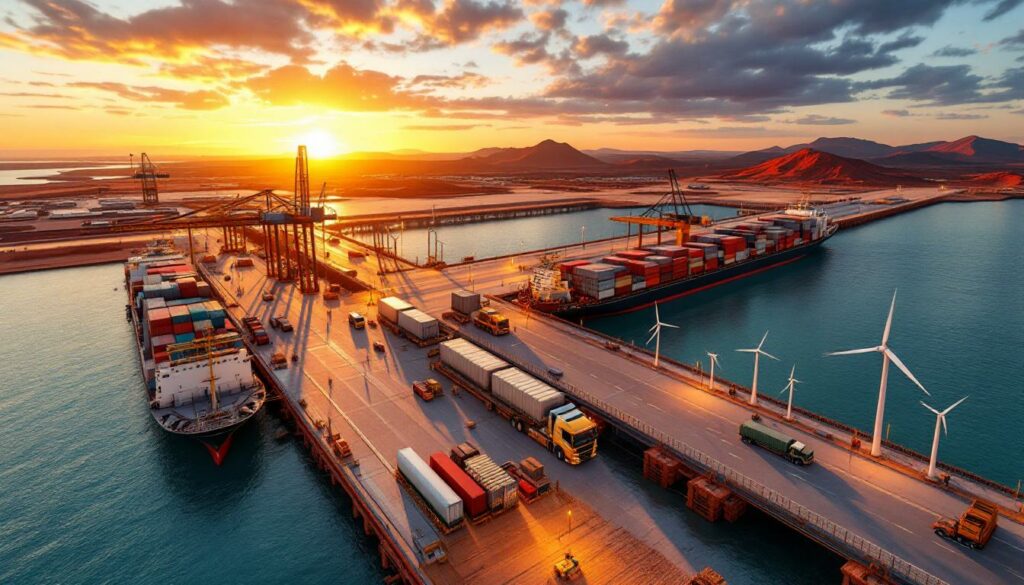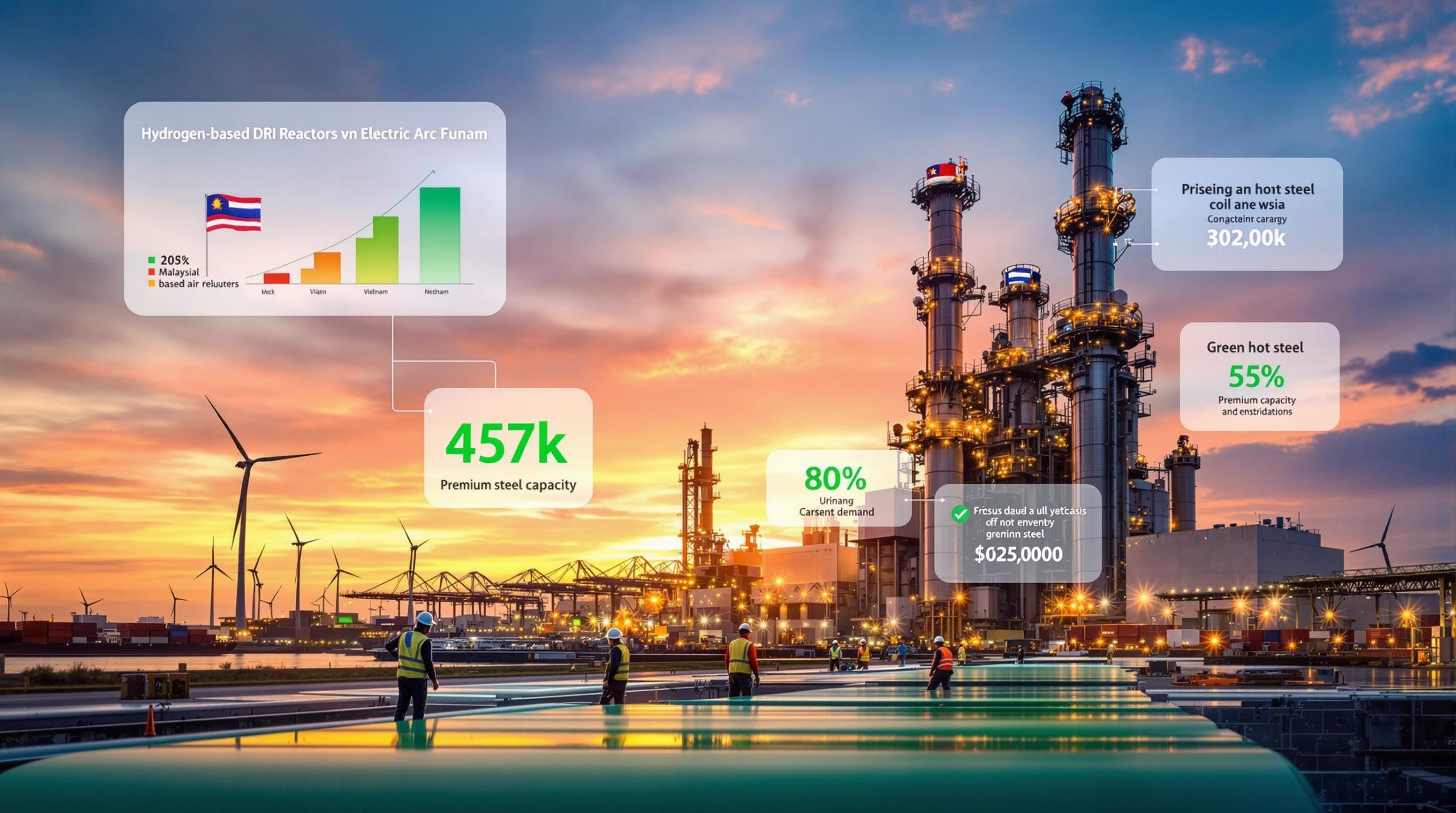What is the Lumsden Point Logistics Hub Project?
The Lumsden Point Logistics Hub represents a strategic $611 million infrastructure investment in Port Hedland, Western Australia, designed to enhance the state's export capabilities and support the growing critical minerals sector. This specialized logistics hub will serve as a vital link in Australia's battery metals supply chain, positioning Western Australia as a key player in the global transition to renewable energy.
The project encompasses multiple components designed to create an efficient, purpose-built export and import facility. Located in Australia's busiest bulk export port, Lumsden Point will primarily facilitate the export of battery metals including lithium and copper concentrates while also supporting the import of renewable energy components such as wind turbines and blades.
"Lumsden Point will unlock significant economic opportunities for the Pilbara, including in battery metals exports and renewable energy," noted Federal Infrastructure Minister Catherine King.
The hub represents a convergence of government and private industry priorities, addressing both economic diversification needs and strategic resource development goals. By creating dedicated infrastructure for critical minerals energy transition, the project aims to support Australia's position as a reliable supplier of materials essential for global decarbonization efforts.
Key Project Components and Development Timeline
Infrastructure Development Progress
Significant progress has already been made on key components of the Lumsden Point development. The 1-kilometer causeway has been completed, providing crucial connectivity between two new wharfs and the logistics hub. This causeway includes a 12-meter-wide road and pipeline corridors designed for efficient material transport.
Other completed infrastructure elements include:
- Seawalls construction
- Dredging work to ensure proper vessel access
- Initial site preparation and ground stabilization
Currently underway are several critical components that will bring the project closer to operational status:
- Manufacturing of specialized mobile harbor cranes designed for handling battery mineral concentrates
- Construction of 2.4 kilometers of new water mains connecting Lumsden Point to the Wedgefield Industrial Area, with Digga Civil serving as the primary contractor
The water mains project represents a crucial utility connection that will support the hub's operational needs while ensuring sustainable water management practices for the industrial development.
Project Completion Schedule
The Lumsden Point development follows a carefully planned timeline:
- First wharf expected to be operational by mid-2026
- Second wharf scheduled for completion later in 2026
- Land allocation agreements already signed with key stakeholders
This phased approach allows for progressive capacity expansion while ensuring that initial operations can begin as soon as the first wharf is ready. The timeline reflects the project's strategic importance to Western Australia's critical minerals sector, with completion dates aligned to expected increases in battery metal production from Pilbara mining operations.
How is the Lumsden Point Project Funded?
Investment Breakdown
The $611 million Lumsden Point development represents a significant public-private partnership with funding from multiple sources:
| Funding Source | Contribution |
|---|---|
| Federal Government | $565 million |
| Western Australian Government | $96.6 million |
| Mining Consortium | $65 million |
The mining consortium contribution comes from five major industry players: BHP, Fortescue, Roy Hill, Hancock Prospecting, and Mineral Resources. This collective investment highlights the strategic importance of the facility to the mining sector's future export capabilities.
The combined government and private sector funding demonstrates the project's significance to both national economic interests and regional development priorities. It reflects recognition of critical minerals as strategically important to Australia's economic future and global supply chain positioning.
Strategic Partnerships
Four land allocation agreements have been signed to secure key operational partners for the logistics hub:
- Australian Renewable Energy Hub (AREH) – Supporting renewable energy component imports
- Kimberley Marine Support Base – Providing marine logistics and vessel support services
- Qube – Delivering specialized logistics solutions for critical minerals
- Toll – Managing transport operations and integrated supply chain services
These partnerships ensure that the hub will have experienced operators managing various aspects of the logistics chain, from vessel services to land transport. The involvement of established logistics providers like Qube and Toll brings industry expertise that will be crucial for efficient operations.
"We are focused on creating jobs, attracting investment and strengthening the Pilbara's role in the global supply chain," said WA Ports and Regional Development Minister Stephen Dawson.
Why is the Lumsden Point Hub Important for Australia's Resources Sector?
Critical Minerals Export Enhancement
The Lumsden Point hub has been specifically designed as a key export channel for battery metals including lithium and copper concentrates from Western Australia's resource-rich Pilbara region. This specialized infrastructure addresses several critical needs:
- Dedicated export facilities for battery minerals that require different handling than traditional bulk commodities like iron ore
- Supply chain optimization for high-value, lower-volume mineral concentrates
- Quality control infrastructure to maintain the integrity of battery-grade materials
- Logistics efficiency to reduce transportation costs for critical minerals producers
As global demand for battery metals continues to grow with the electric vehicle revolution and renewable energy expansion, the hub positions Australia to capitalize on its abundant lithium and copper resources. The Pilbara region alone hosts world-class deposits including the Pilgangoora and Wodgina lithium industry innovations that are transforming the sector.
The facility will help Australian miners reduce their export costs while ensuring reliable supply chains to international markets, particularly battery manufacturing centers in Asia and emerging manufacturing hubs in Europe and North America.
Economic Benefits for Western Australia
The Lumsden Point project delivers significant economic advantages beyond simply facilitating exports:
- Job creation during both construction and operational phases
- Skills development in advanced logistics and materials handling
- Supply chain diversification reducing dependence on single export channels
- Regional economic stimulation through increased business activity in Port Hedland
- Trade relationship enhancement with key battery manufacturing nations
By strengthening the Pilbara's role in global supply chains, the hub contributes to Western Australia's economic resilience and creates opportunities for value-adding activities related to the critical minerals sector. The WA resource sector impact continues to grow beyond traditional resources, with the project aligning with broader state objectives to diversify while leveraging existing competitive advantages.
How Will the Lumsden Point Hub Support Australia's Energy Transition?
Renewable Energy Infrastructure
The Lumsden Point facility will play a dual role in Australia's energy transition by not only exporting the minerals needed for global renewable technology but also facilitating the import of renewable energy components:
- Large-scale wind turbines and blades
- Solar panel infrastructure
- Energy storage components
- Specialized renewable energy equipment
This import capability is particularly significant for the nearby Australian Renewable Energy Hub (AREH) project, which aims to develop massive renewable energy capacity in the Pilbara region. The specialized handling facilities at Lumsden Point will enable efficient unloading of oversized components like wind turbine blades that can exceed 80 meters in length.
By creating dedicated infrastructure for both the inputs and outputs of the clean energy supply chain, Lumsden Point creates a virtuous cycle supporting Australia's transition to renewable energy while exporting the minerals that enable global decarbonization efforts.
Regional Development Impact
The establishment of the Lumsden Point hub will have transformative effects on Port Hedland and the broader Pilbara region:
- Enhancement of Port Hedland's capabilities as a multi-commodity port
- Support for the Pilbara's transition to renewable energy industries
- Creation of opportunities for new businesses in the clean energy supply chain
- Development of specialized skills in the local workforce
- Attraction of additional investment in related industries
These impacts extend beyond direct economic benefits to include broader regional development advantages. The hub will help diversify the Pilbara's economic base, historically dominated by iron ore exports, creating more resilient communities less vulnerable to commodity price fluctuations.
By positioning the region as a critical node in both battery mineral exports and renewable energy imports, Lumsden Point helps secure the Pilbara's long-term economic future in a decarbonizing global economy.
What Makes the Lumsden Point Project Strategically Significant?
Geographic Advantages
Lumsden Point's location provides numerous strategic benefits that enhance its value as a logistics hub:
- Situated in Port Hedland, Western Australia's busiest port with established shipping routes
- Proximity to major mining operations in the mineral-rich Pilbara region
- Strategic position for both import and export operations
- Access to existing rail and road infrastructure connecting to inland mining regions
- Sufficient water depth to accommodate specialized vessels after completed dredging work
These geographic advantages reduce transportation costs and time for both exporters and importers, creating efficiencies throughout the supply chain. The hub's location within an established port precinct also means that supporting infrastructure and services are already in place, reducing development costs and accelerating the timeline to operational status.
Industry Diversification
The Lumsden Point development represents a significant step in diversifying Western Australia's export infrastructure beyond traditional bulk commodities:
- Reduces dependency on iron ore export facilities
- Creates specialized infrastructure for emerging critical mineral industries
- Supports Western Australia's economic diversification strategy
- Enables growth in value-added processing and specialized logistics services
- Facilitates development of new supply chain capabilities in the region
This diversification is particularly important as global markets evolve with the energy transition. By developing infrastructure specifically designed for battery-grade lithium projects and renewable components, Western Australia positions itself for continued relevance in changing global markets.
The project aligns with broader economic development goals to reduce the state's vulnerability to commodity cycles while leveraging its natural resource advantages in new ways.
What Government Support is Behind the Project?
Federal and State Backing
The Lumsden Point project has received strong support from both Federal and State governments, demonstrated by significant financial commitments and policy alignment:
- Federal Government contribution of $565 million
- Western Australian Government investment of $96.6 million
- Public endorsements from key ministers including Federal Infrastructure Minister Catherine King
- Ongoing support from Western Australian Ports and Regional Development Minister Stephen Dawson
This bipartisan support reflects the project's strategic importance to Australia's economic and resource development goals. The substantial government funding also indicates confidence in the long-term economic returns expected from enhancing critical mineral export capabilities.
"Progress is accelerating," noted WA Ports and Regional Development Minister Stephen Dawson. "We are focused on creating jobs, attracting investment and strengthening the Pilbara's role in the global supply chain."
Policy Alignment
The Lumsden Point development aligns with multiple government policy objectives:
- Australia's Critical Minerals Strategy – Enhancing export infrastructure for priority minerals
- Renewable energy transition goals – Supporting component imports for clean energy projects
- Supply chain resilience initiatives – Creating alternative export channels for strategic resources
- Regional development priorities – Strengthening economic opportunities in the Pilbara
- Trade diversification objectives – Reducing dependence on traditional commodity exports
This alignment across multiple policy areas has helped secure the substantial government funding committed to the project. The hub represents a tangible implementation of strategic priorities outlined in Australia's resources and energy policies, moving beyond statements of intent to concrete infrastructure development.
FAQ About the Lumsden Point Logistics Hub
When will the Lumsden Point facility be fully operational?
The project is being completed in phases, with the first wharf expected to be operational by mid-2026 and the second wharf scheduled for completion later that year. Some components, including the causeway, seawalls, and dredging work, have already been completed.
Which companies are involved in funding the project?
The $611 million project receives funding from multiple sources:
- Federal Government: $565 million
- Western Australian Government: $96.6 million
- Mining consortium: $65 million collectively from BHP, Fortescue, Roy Hill, Hancock Prospecting, and Mineral Resources
What types of materials will be exported through Lumsden Point?
Lumsden Point is designed primarily to facilitate the export of battery metals such as lithium and copper concentrates, supporting Australia's critical minerals sector. These materials require specialized handling facilities different from traditional bulk commodities like iron ore.
How will Lumsden Point support renewable energy development?
The facility will serve as an import hub for renewable energy infrastructure components, including wind turbines and blades. This dual functionality supports Australia's transition to green energy while also facilitating the export of minerals required for global renewable technology manufacturing.
What land allocation agreements have been established?
Four strategic land allocation agreements have been signed with:
- Australian Renewable Energy Hub (AREH)
- Kimberley Marine Support Base
- Qube (logistics provider)
- Toll (transport and logistics company)
These agreements ensure that key operational partners are secured for the hub's long-term success.
What infrastructure components have been completed so far?
Completed infrastructure includes:
- 1-kilometer causeway connecting wharfs to the logistics hub
- Seawalls construction
- Dredging work to ensure proper vessel access
Currently in progress are the manufacturing of mobile harbor cranes and the construction of 2.4 kilometers of water mains connecting to the Wedgefield Industrial Area.
The Future of Critical Minerals Export Infrastructure
The Lumsden Point development represents more than just a logistics hub; it embodies Australia's strategic pivot toward positioning itself as a critical minerals superpower in a decarbonizing global economy. As one of the largest dedicated critical minerals export facilities in development globally, the project highlights Australia's commitment to maintaining its resource leadership beyond traditional commodities.
For the battery minerals sector, the specialized infrastructure addresses long-standing logistics challenges that have sometimes constrained growth. The efficient export channels will potentially reduce costs for producers while ensuring reliable supply to international markets increasingly concerned with supply chain security for materials essential to energy transition.
The coming years will demonstrate whether this investment delivers the anticipated economic diversification and export growth. However, the strong public-private partnership behind the project suggests confidence from both government and industry that Lumsden Point will become a crucial node in the global critical minerals supply chain, potentially influencing future copper price insights as export capacities expand.
Ready to Spot the Next Major Mineral Discovery?
Discovery Alert's proprietary Discovery IQ model instantly notifies investors about significant ASX mineral discoveries, turning complex data into actionable insights for traders and long-term investors alike. Explore historic discoveries and their exceptional returns by visiting our dedicated discoveries page and position yourself ahead of the market.




